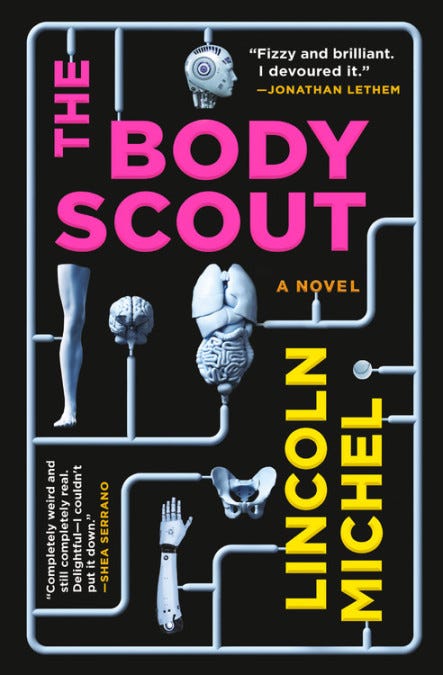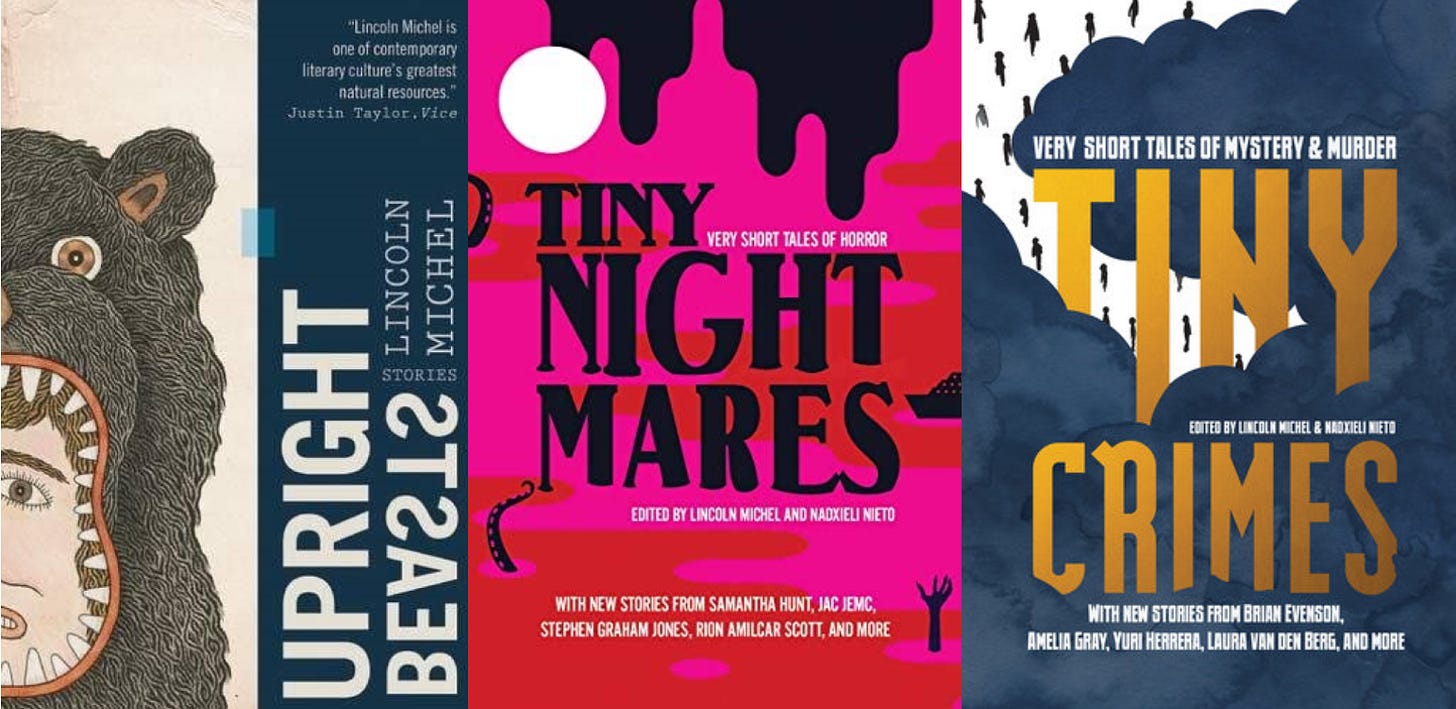Shared posts
DP FICTION #111B: “How to Kill the Giant Living Brain You Found in Your Mother’s Basement After She Died: An Interactive Guide” by Alex Sobel
DP FICTION #111A: “Ketchōkuma” by Mason Yeater
DP FICTION #109B: “The Offer of Peace Between Two Worlds” by Renan Bernardo
DP FICTION # 109A: “Level One: Blowtorch” by Jared Oliver Adams
DP FICTION #102B: “Shalom Aleichem” by Y.M. Resnik
On the State of Literary Magazines
This week, Fantasy magazine announced it was shutting down three years after it rebooted. Fantasy did great work in those years and their stories were regular SFF award contenders. Still, editors Christie Yant and Arley Sorg wrote “People will want to know why, of course, and the answer is the expected one:…
DP FICTION #102A: “On a Smoke-Blackened Wing” by Joanne Rixon
DP FICTION #99B: “Diamondback V. Tunnelrat” by Nick Thomas
DP FICTION #99A: “Six Reasons Why Bots Make the Worst Asteroid Miners” by Matt Bliss
My Sci-Fi, Fantasy & Horror Short Fiction Roundup - April 2023
An audio version of this roundup is available on YouTube:
The Time Traveler’s Cookbook by Angela Liu in Cast of Wonders (narrated by May Chong)
Don’t eat dinosaur. Just don’t. Mom marked it as a must-have, saying it looks and tastes “like an exotic giant chicken,” but just getting to the meat has been a nightmare. The skin’s teeth breakingly-tough and the sucker hooked me in the thigh with one of its nasty claws during the hunt. I’ve staunched the bleeding with Happy Time Traveler’s super medical glue, but holy hell it still hurts.
Oh how I love this story. It's a time travel story that is both whimsical and heartbreaking. The food, the recipes, the time travel tips... they're all fabulous and funny, but Liu's story is also a deeply emotional tale about family and grief and about trying to find a way to move forward, even when it's the hardest thing we'll ever do.
Crown Prince by Melissa Mead in Cast of Wonders (narrated by Jordan Kurella)
Behind a gauze screen, Crown Prince Manu slumps in his cushions. He’s grateful for the screen, hiding his lapse from Father’s petitioners. It takes so much energy to maintain his Stupid Body in anything like a posture of alertness. The more effort he puts forth, the more it writhes about. The law says that he, the Only Royal Son, must be present at all official proceedings, but behind the screen no one can see him if he chooses to save his energy for listening. He always listens. And remembers.
This is a fairytale about Manu, a prince with a difference: he has cerebral palsy. Mead's story deals with cerebral palsy, the challenges for Manu, and how his condition makes others view him differently and often underestimate him (sometimes at their peril!). To quote the CoW story commentary:
Accessibility isn’t just about giving people access to support tools to engage more fully with society – it’s also about re-shaping society such that all people are included, regardless of their circumstances, with as much or as little extra support as they want or need.
I love this story for its fresh perspective and its terrific characters, and I also love it for the entertaining palace intrigue. Sadly, Mead passed away in 2022 before this story was accepted and published by Cast of Wonders.
✴
, Bird by Uyen Dang in Necessary Fiction
Several years ago, the rain started stripping people of their memories. With every rain a memory or two would dissolve into oblivion only to later reappear, suddenly, in physical form, at the edge of the city. Cats, childhood homes, a beloved dead houseplant… Some believed it was a weird symptom of climate change. Others said it was divine punishment, that the rain was actually godly spit, an amnesiac. Hard to believe, but they claimed it true. There was something vengeful happening here, they could feel it.
This is a surreal and uniquely imagined story where memories are stripped away but do not disappear. I love the unabashed strangeness here, and the way that strangeness is made real and tangible. Dang's evocative prose has the feel and melody of poetry, giving this story real depth and heart.
✴
Through the Glass, a Full Sea by P.H. Low in Apparition Lit
There is a girl behind the mirror.
You see her first when you are five, pinching your nose and cheeks and wondering if the greenish shade of your skin, which you’ll later learn is just the tint of glass, means you are made of cheese. She moves a half-breath before you do; speaks a language you have already forgotten, her pink mouth forming a childish perfect
Nǐ sì séi?
A life, and the process of trying to understand yourself and the world and what your life can be, what YOU can be and what you want to be, is captured with exquisite brilliance in this short story. Low twists in a strand of horror, with the recurring presence in mirrors and other reflections, but the pain of this story goes beyond horror tropes. Beautiful, heart-rending darkness.
✴
The Librarian and the Robot by Shi Heiyao in Clarkesworld (translated by Andy Dudak)
One day, the Curator salvaged a robot. It was a model ST-19, a military machine, designed for search and destroy missions. The Curator found it outside in a knee-deep snowdrift. The robot’s ship had crashed into a hill two kilometers away, the explosion cutting the summit right off.
A lquietly moving science fiction story about a far-future where humans have left Earth and colonized other planets, but where one person, the Curator, has returned to the old home-planet. There, she finds an old library and begins to salvage books. And when she salvages a military robot, she finds new uses for it too. I love the gentleness of this story as it explores human nature and the nature of artificial intelligence, and how we can become something different than the world wants to make us into.
Voices Singing in the Void by Rajan Khanna in Clarkesworld
On Narraweena-4, the Builders have begun.
A Worker drone surveys its assigned territory as its tunneler beam warms. A fluting call pierces the air, answered by a warbling trill. The drone pauses. Its code, shared with others of its kind, sings the story across their web. A Scanner glides free of its dock, winging toward the lifeforms, far enough away that it won’t alarm them. Optics and sensors identify two arboreal creatures, each clinging to a tree branch, their gray, spotted hide fringed by feathers of blue and vermilion.
A hauntingly beautiful science fiction story with a deep sadness and sense of loss at its heart, yet it's not without hope and wonder. On various planets in the universe, human-constructed artificial Builders have constructed places where people were supposed to live, and yet, no people have arrived. Khanna's story travels to these different worlds and sees them through the eyes and minds of the Builders, and then returns to Earth where we learn the difficult truth. There's an epic sweep and feel to this story that gave me chills.
✴
One Eye Opened in That Other Place by Christi Nogle in Three-Lobed Burning Eye
They were tied up together from the start: Dottie and that other place. That other place, that other eye. Charles didn’t like to think of it as a third eye, though that’s what it was. It wasn’t in his forehead, wasn’t in the center of his face at all. Instead, it rested between the right side of his nose and the tear duct. It wasn’t actually there, of course, and yet it felt like it was there.
A new issue of Three-Lobed Burning Eye is always good news if you like your speculative fiction dark and weird. Nogle's story, about a man who can see another place with his third eye, is dark and weird and deliriously unsettling. There's a quiet, ever-increasing strangeness to this story that is both mesmerizing and disturbing. And the ending? The ending is a scream.
✴
Kudzu Boy Dreaming by SJ Powell in FIYAH #26
He’s ten years old when he finds the body in the kudzu patch.
A boy and his mother live in a house where there is magic, both protective magic and terrifying magic, at play. Beyond the house, the kudzu grows and one day, the boy finds a dead body there. Powell's story has a dreamlike undercurrent, but is also firmly rooted in a real and vividly drawn world, that is seen through a child's perspective: what is real and what isn't, what is dangerous and what is not, are not always easy to determine. And there's a dream/nightmare sequence in this story that is absolute terrifying perfection, and that scene is going to haunt me for a while.
✴
Root Canticle by Natasha King in Nightmare
Oh, dear. Don’t bother going back up the stairs. Yes, they exist still, but the door at the top will no longer take you anywhere you would wish to go. Look—the vines, if that is what we want to call them, have made some room. Sit.
I love this unsettling, hallucinogenic, twisting tale that goes into the past and into the earth, and into bodies as well. There's an old magic at work here, old stories and tales that have taken root, and King spins a beautifully mesmerizing tale from all of it.
✴
Victory Condition by Eliot Peper in Anthropocene
Yes, the Golden Gate Bridge still stands—one of the few historical artifactchs outside the city’s gleaming walls. Of course, the bridge no longer serves the purpose for which it was built: to offer vehicles efficient passage up and down the California coast. Now, it’s primarily a wildlife crossing for wolves, grizzlies, antelope, jaguars, coyotes, and elk. People visit too.
A thought-provoking future tale by Peper about a world, and a city, that has changed fundamentally and where human beings are finding new ways to live. Peper has some interesting thoughts on this future SF, but what I loved the most about this story is the way it interweaves the history of old San Francisco with the future of the new, and the way both nature and city feature so prominently in the telling.
✴
Our Exquisite Delights by Megan Chee in Lightspeed
Almost everyone has, at some point in their lives, encountered a door that was not there before.
A little girl sits up in bed, staring at the two identical closets in her bedroom. She feels certain there had been only one when she fell asleep.
Oh, this is a great twist on portal fantasies, and all those fantasy tales about doors, leading people to other places. Here, we see these doorways from the other side, from the perspective of whatever lives beyond those doors. There's slow-burning twist to this tale and the point of view of the narrator that makes it even more satisfying.
Construction Sacrifice by Bogi Takács in Lightspeed
There’s dysphoria, and then there’s turning into a mid-size city. But sometimes you try male, you try female, you try different kinds of nonbinary and it only makes you realize that something still doesn’t quite fit, something fundamental. There is a mismatch.
What an absolutely enthralling story this is. It’s told from two points of view: one is the city of Fejértorony, a city that has a mind of its own quite literally; the other is Mihue, a scholar called a clairvoyant who comes to the city to study it and gain a deeper understanding. What follows is a connection between these two that has unexpected and life-altering consequences for them both. Takács calls it a “a secondary-world science fantasy story about trans love in difficult circumstances.” And for more about the inspiration for the story, read the excellent interview in Lightspeed: https://www.lightspeedmagazine.com/nonfiction/author-spotlight-bogi-takacs-2/
✴
Locavore by Kim Harbridge in Strange Horizons
It forced itself to take that last step onto the ferry. Every step further from land felt like falling. Through space, through time, through every place it had ever been. It kept its eyes open, its features arranged in what it hoped was a neutral expression. Somehow, it walked itself up to the small covered passenger deck and took a seat on a plastic bench. The boat began to move.
This is such an excellent and fresh take on a horror story of shapeshifting monsters. Being a shapeshifter and a monster, isn't always easy as this story points out. You have to be careful, you have to consider your options, in order not to get caught, not to get found out and still survive. Harbridge's story is both quiet and powerful, and I love the intimate, under-the-skin view we get of the kind of being that is usually only glimpsed in the shadows.
✴
The Air Will Catch Us by Rajiv Moté in Reckoning
Walking is different now. The air resists my habitual gait. Little hops lift me into the thickened atmosphere that slows my return to Earth. It’s undignified, but it’s past time I got used to this. I’m not that old. I bob along after her.
A quiet, contemplative science fiction story set in a future where humanity has had to make some drastic changes in order to survive. These changes are the new reality for the children growing up in it, but for those who still remember the world, and the air, as it once was, it's a different story. There's a bitter-sweetness and wistfulness to this story that really got to me.
✴
The Dark House by A.C. Wise in TOR.com
It didn’t help that darkness crowded the edges of the photograph, smudged, like thousands of fingerprints marring the picture over the years. I would have blamed the quality of the reproduction, except the shadows gathered in the windows too. They didn’t reflect light so much as hold it at bay.
A profoundly unsettling and increasingly harrowing story by A.C. Wise about a house, about the ghosts that haunt that house, and about the lives that seem tied to the photos left behind in that house. There's a terrifying inevitability to the horror here: everything has happened before and will happen again. Wise has a terrific ability to crank up the intensity of horror with masterful precision, and that skill is on full display in this story.
The Lone Drummer by A.G. Lamar in Beneath Ceaseless Skies
I love stories that tie together music and magic, and in A.G. Lamar’s story, we find ourselves in world where songs and drumming can be used for peaceful purpose, like making crops grow, and for war, as a weapon to defeat your enemy on the battlefield. Kamu is a young boy with a great gift for drum magic. At a young age, his father sent him off to hone his skills and become part of the royal army. Lamar’s story is a multi-layered and fascinating look at a society that wields magic for a variety of purposes, and at the heart of the story is Kamu, who is so very good at magic and drumming, but who is also deeply conflicted by going to war, and who still carries the pain of being sent away from his family when he was only 10 years old. It makes for a riveting and thoroughly compelling read set in a fascinating world.
✴
We, the Ones Who Raised Sam Gowers from the Dead by Cynthia Zhang in PseudoPod (narrated by Serah Eley)
There’s a profound fierceness and anger fueling this story, making it intensely powerful and affecting.
Yes, to answer your questions, we were the ones who did it; we were the ones who dabbled into the forbidden arts, who so casually threw away the good Christian values of our country for a flash of bloody vengeance. We are the ones you want, the ones who raised Sam Gowers from the dead.
The voice of the story is so strong and bold, and I love how it never shies away from telling us the truths we already know but sometimes try not to face: the injustice, the cruelty, the bigotry, the violence faced by Sam Gowers and others like him. Oh yes, I love the sharp teeth of this story, the raw emotion that runs through it, and I love how powerlessness is turned into unexpected, unimaginable power when necromancy is used.
✴
A Thousand Echoes in One Voice by Deborah L. Davitt in Podcastle (narrated by Dave Robison)
At first, you didn’t really commit to it. You only explored on weekends. Then it became an all-consuming obsession. You took your instructions from the hidden graffiti. Your only guide, the only proof that there were others like you. Your sole consolation.
The others exist. Some of them must go home again. And some of them never can. Caught, perhaps, when a reality blinks out of existence.
Oh, my kind of story: a messed up timetravel tale, where different choices make new timelines, where worlds diverge and join, and where the paths to the past and the future and the other worlds are difficult to find and understand. Davitt’s story is haunting and evocative, with a deep and dark heart. That ending gave me bone-deep chills.
✴
Sounds for Crustaceans by Addison Smith in Fantasy Magazine
OK, so a while back I was talking on Twitter about crabs and how easily lifeforms through the eons seem to turn into crabs (it’s a thing!), and then someone recommended I read this story by Addison Smith. It’s from 2021, so I’m obviously way late in covering it here, but wow, what a story it is! Here, someone is turning into a crustacean, but it’s not an easy process and it’s not easy to know what other people are going to think about such a transformation. Will they even believe it? Will they mock it? There’s a surreal vibe here, and a tenderness beneath the chitin, that is an absolute delight.
✴
If you want to support my work, check out my Patreon or Ko-Fi.
DP FICTION #98A: “Re: Your Stone” by Guan Un
Diabolical Thoughts

Big week for me: DIABOLICAL THOUGHTS is live!
This is the special telepathy issue that I’ve guest-edited for Diabolical Thoughts. Four stories about sharing minds and thoughts — and, as is Diabolical’s wont, these stories zip between the surreal, the delightful, the unsettling and the intimate. Or all of them together. They’re all wonderfully strange and unexpected, and as you might imagine, I love them all dearly.
You can read the entire issue right here.
Here’s the full table of contents:
Editorial: Thoughts on Thoughts, by Ziv Wities, 410 words
The human brain has got a lot to answer for.
Rattenkönig, by Jenova Edenson, 3650 words
Three tangled teens on a road trip have nothing but each other.
The Hivemind’s Royal Jelly, by Josh Pearce, 860 words
BEES
The Desert’s Voice is Sweet to Hear, by Carolina Valentine, 3870 words
The desert had been trying to kill Zazy for two days. Gently. Lovingly.
A Girl With a Planet in Her Eye, by Ruth Joffre, 870 words
At first, the planet in the aqueous humors of her left eye was silent. And then: music.
Issue #97: Our Special Telepathy Issue, Diabolical Thoughts!
DP FICTION #96A: “The Monologue of a Moon Goddess in the Palace of Pervasive Cold” by Anja Hendrikse Liu
Fairy Tale as MFA Antidote
I often start my MFA courses with a discussion of fairy tales. It seems an obvious place to start, since fairy tales are some of humanity’s oldest stories and likely the first stories that my students remember reading as children. But I also love starting with fairy tales because they violate more or less every single rule of fiction writing that is drilled into us in creative writing classes.
Instead of “show don’t tell,” fairy tales prioritize telling over showing. Instead of demanding “round characters,” fairy tales embrace flat ones. Instead of logical “worldbuilding,” fairy tales operate with a surreal dream logic in abstract settings. Instead of starting “in media res,” they start “once upon a time.” Instead of “telling the story only you can tell,” fairy tales ask you to retell stories that have been told for centuries. So on and so forth.
Almost nothing you are taught about setting, character, voice, or structure in MFA classes or craft essays applies to the fairy tale form. And yet the form endures. Fairy tales still serve as source material for many of our novels and movies, and plenty of acclaimed contemporary writers deploy versions of the form. (I’m currently reading Kelly Link’s forthcoming story collection, White Cat, Black Dog, which opens with a terrific modern fairy tale.)
I’m not suggesting that the traditional writing advice is wrong, per se. Plenty of brilliant stories are written with all the usual advice. But we should always remember that there are no writing “rules,” there are only standards that apply to certain modes of storytelling. Those modes wax and wane in popularity. They chance according to culture and history. And there are infinite modes we can choose from.
So what is the mode of the fairy tale? What is the form? Here I defer to Kate Bernheimer, a great contemporary scholar (and writer) of fairy tales who outlines four qualities in her essay “Fairy Tale Is Form, Form Is Fairytale.” (The essay can be found in the Tin House’s The Writer’s Notebook, which I highly recommend as a craft book.) The four qualities Bernheimer describes are:
Flatness—specifically flatness of character. Fairy tales don’t delve into the psychology or interiority of characters, and typically limit them to one or two adjectives. The beautiful princess. The evil king. Etc. Similarly, fairy tales don’t have traditional character arcs or worry about “dynamic characters.” The evil witch at the start is probably going to be an evil witch at the end.
Abstraction—a general minimalism of description. Only a few colors are used and details are abstracted. “A young woman lived in a small house by the dark woods,” rather than a detailed layout of the house and a catalogue of the the types of trees in the forest.
Intuitive logic—essentially a dream logic or poetic logic, not far removed from what we would call “surrealism” or “magical realism” in a contemporary story.
Normalized magic—probably self-explanatory: magic is normalized. Characters are unsurprised if a cat begins to talk or a mermaid swims by. There is no SFF worldbuilding to explain or rationalize the fantastic elements.
To these four, I would add two more:
Open artifice—fairy tales eschew the standard methods of hiding fictional artifice and instead present themselves as pure story. As yarn, joke, fable. Fairy tale narrators often interject commentary or address the reader. And the classic fairy tale frame tells us we’re entering and then leaving pure story. These days, the classic frame has been reduced to “Once upon a time…” and “…happily ever after.” In traditional fairy tales, the openings and closings were even more overt in telling you “this isn’t real”: “Once there was, there never was” to start, say, and something absurd like the following to close: “I was also there in my red trousers and ate a lentil on a spit and if that lentil fits on the spit then you also have to believe my tale.”
A non-setting—fairy tales typically take place in a vague non-setting, in which we are never pinned down in specific time periods or locations. “Once upon a time a beautiful princess lived in a golden castle” instead of “In the 12th century, the heir to the Hapsburg dynasty lived in a castle by the Aar river” or what not. Specific names, dates, and locations—whether real or invented—deflate the fairy tale mode.
Although Americans raised on Brothers Grimm might think of this non-setting as being always a vague medieval world, the non-setting can take place any time (so to speak) including far future science fiction settings or the present day as long as we don’t pin the setting down too neatly. “Once upon a time a lonely salesman lived in a big city and every day he took a taxi to work…” perhaps, but not “In 2023, an NFT salesmen lived in the Fisherman’s Wharf district of San Francisco and every day he took an Uber to a Starbucks with his laptop to work.”
These six essential qualities of fairy tales stand out first because they, as said, go against all the standard advice of both contemporary literary fiction and SFF writing. We’re told to be specific in our settings, logical in our worldbuilding, and to probe the psychological depths of our characters. That advice works wonders for many types of stories. But the qualities of fairy tales allow for different types of stories and different effects. Fairy tales in their abstractness, artifice, and flatness allow stories to operate on different planes. The philosophical, sexual, or primal fears. They are somehow both more Apollonian and more Dionysian at the same time.
Listing the features of fairy tales in the way above, you can probably can see the different ways fairy tales overlap with other modes of storytelling. The normalized magic and intuitive logic is present in magical realism. The non-setting is present in a lot of weird fiction. And the open artifice and flatness is a frequent feature of postmodern fiction and metafiction.
Of course, as writers we can always pick and choose what we want. A lot of the best fairy tale-inspired fiction takes most of these features but completely ditches one or two of them. Angela Carter’s brilliant collection The Bloody Chamber hits most of these points yet in place of the minimalist abstraction she substitutes her lush, Gothic prose. Helen Oyeyemi’s many fairy tale retelling novels keep a lot of the fairy tale style, but probe the psychology of her characters in specific settings. Postmodernists like Robert Coover and Donald Barthelme—both known for fairy tale retellings—tended to keep the flatness and artifice yet write in their own playful styles full of details and lists.
So, when I suggest fairy tales as an MFA antidote I don’t mean that you must use all six of these features—although I certainly wouldn’t mind if you did. The world can always use more fairy tales. As writers we always get to mix and match, pick and choose. If one of your stories is feeling stale, perhaps try using an old fairy tale technique. Embrace your artifice, flatten your characters, or make your worldbuilding a bit more nonsensical. And don’t believe anyone who tells you that all stories “must” have round characters or logical worldbuilding or anything else. Stories come in infinite forms, which is as true once upon a time in a land far far away as it is today.
UPDATED 2/9: Since this post was so popular, I’ve written a follow-up post with some recommendations for contemporary fabulist books:
Counter Craft is a reader-supported publication. To receive new posts and support my work, consider becoming a free or paid subscriber.
If you like this newsletter, consider subscribing or checking out my recent science fiction novel The Body Scout that The New York Times called “Timeless and original…a wild ride, sad and funny, surreal and intelligent.”
Other works I’ve written or co-edited include Upright Beasts (my story collection), Tiny Nightmares (an anthology of horror fiction), and Tiny Crimes (an anthology of crime fiction).
DP FICTION #95B: “Tell Me the Meaning of Bees” by Amal Singh
Writing Novels? Read Short Stories
This morning I stumbled across a Reddit thread with a familiar question:
As an author, what novels should I read?
Like a lot of questions arising in casual writing talk, and especially the “should I” questions, this is almost certainly the wrong thing to ask. There’s no one answer, no one path. But it does make sense to wonder how you might read more deliberately, broaden your horizons, read in a way that strengthens your craft — which, overall, is what the original poster was after, and is what most of the responses dove into.
Perhaps unsurprisingly, my own contribution was this:
Read short fiction as well as novels.
Here’s what I wrote:
Read short fiction as well as novels.
Short fictions is a different form, with different constraints. Different strengths and weaknesses — and learning those, at least learning how to recognize the range and versatility, will give you a lot.
Short stories do cool stuff. A great short story can make you love a protagonist and then kill them off in the space of 25 pages. A great short story can pull off things you could never sustain for the length of a novel, like being written from the POV of a sentient refrigerator, or as the transcript of a YouTube channel, or where linear time is not actually a thing. Short stories can also focus on something really small, intimate, or odd — a single date; a snapshot of one compelling character; a single captivating thought-experiment. So reading a diverse array of short stories will keep setting off lightbulbs of "I didn't know you could do that" — and those lightbulbs will carry over to your novel-writing as well, because you'll have all these tools and tricks and techniques in the back of your mind. You'll know a hundred different ways you can stretch your writing to be different, and to accomplish different things.
Short stories are a masterclass in compactness. In getting information across really quickly and smoothly (and also, knowing what information is worth getting across, and what's better left as vibes-only); in favoring scenes and substance over preparatory conversations; in cutting right to the heart of a story and also convincing readers this is a story worth reading all at once. In a great short story, most every paragraph is doing double or triple duty, establishing character and introducing the setting and rules and moving the plot forward, all at the same time.
That's all craft you absolutely want and need in novel-writing as well. You want your novel to feel tight, not flabby; you want your big overarching story to be full of scenes and subplots that function very similarly to the way short stories do; you want those sub-stories to be compelling, and you want not to feel like the same thing over and over, or like one big thing that just keeps stretching on and on interminably.
Short stories teach endings. One of the great strengths of novels is a sense of immersion, of going on a journey with particular characters or in a particular setting. But there are so many novels where the ending is lackluster, or just... y'know, fine, but not the high point of the book. The journey was worth it in its own right. That's why you can still pick up Song of Ice and Fire or Name of the Wind and enjoy what there is of it, even if the next installments never materialize. The anticipation can be better than when it actually arrives. But short stories are tight, and focused, and bound to their endings in iron. They're too brief for the separation between "middle" and "end" to feel like two different things. If you read one anthology of a dozen stories, then congrats: you have read a full dozen endings, each of their own shape and type and style. Pay attention to what makes something feel and function as an ending, and you'll learn a lot.
Where novels are a commitment, short fiction can be a playground, a gallery tour, a lab for glorious experimentation. If you want to know what's out there, and see the full range of what this craft can do, I strongly advise you not to miss out on it. :)
Here's a little grab-bag of stories from all kinds of different types and styles:
"Magic for Beginners," by Kelly Link, eerie, ethereal magic in the mundane.
"Please Undo This Hurt," by Seth Dickinson, sorrow and existential horror.
"A Fine Balance," by Charlotte Ashley, swashbuckling and intrigue.
"Who Will Greet You At Home," by Lesley Nneka Arimah, literalized metaphor and social inequality.
"Lies I Never Told You," by Jaxton Kimble, sweet, gentle, affirming.
"The Long Way Up," by Alix E. Harrow, mythology retelling from a relatable, intimate, contemporary POV.
"A Strange and Muensterous Desire," by Amanda Hollander, wonderfully ridiculous character humor.
“How Music Begins,” by James Van Pelt, familiar people placed in strange and desperate circumstances.
Hope this helps whoever stumbles across it, and hope you enjoy!
DP FICTION #95A: “Dog Song” by Avi Naftali
Ziv WThis one is SO. MUCH. FUN.
A Jack Kirby Story
I'm not sure I've ever told this story anywhere in public. Forgive me if I have…and please, as you read it, keep in mind that I was eighteen or so at the time. At any age, it's possible to say something off the top of your head that comes across as rude (when you didn't intend rude) and/or seriously meant (when you intended it as a joke). And it's more likely at that age when you're kind of an adult and kind of not-an-adult and not quite sure how to be either.
People always ask me what my pal Steve Sherman and I did on those comics where we "assisted" Jack Kirby, as on his Fourth World comics and Jimmy Olsen. The honest answer is "very little." We did some production work. We wrote some storylines, a few of which he used some of. Our greatest contributions might have been when we listened to him describe a story he was about to start working on and we said something like, "That sounds great, Jack!"
Once in a while, when he then wrote and drew that next story, it would even wind up resembling the story he'd told us.
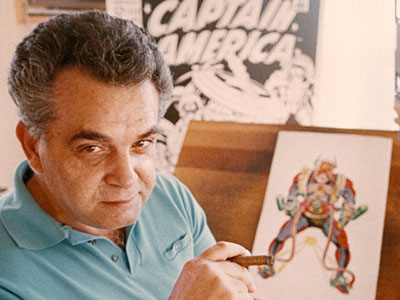
I sometimes had an added duty. If Superman was in the story, Jack would usually not draw in Superman's chest insignia as he went along. He never quite "got" the way it was supposed to look. It was not the kind of thing Jack Kirby could have cared a lot about and the folks back at DC Comics in New York treated it as a major defect in the work. The inker or one of the guys they had on staff back there could have fixed all the emblems in one story in, literally, about three minutes but this was somehow a big issue.
At times, it felt like given the choice of an exciting, dynamic story with chest emblems that needed some correction or a boring, hackneyed story with proper emblems, they'd have preferred the latter. So Jack would leave Superman's chest barren until such time as he was ready to send the story off to New York.
If — and only if — it would not delay delivering the job much, he would wait for a day when Steve and I were there and Jack would have me draw in all those "S's" throughout the story. It was the only thing — and I mean the only thing — I could draw better than Jack. He'd go outside for a breath of canyon air, I'd sit at his drawing table and do it, and by the time he came back in, it would all be done.
If, however, we weren't coming out to work in the next day or two, he would draw them in by himself, ship the story off to New York and then brace himself for the inevitable phone call from someone: "Jack, you're getting Superman's emblem wrong again…"
So one day, Jack was an hour or two from finishing a Jimmy Olsen story and we were there. I was doing busy work, waiting for my moment, sneaking glances at whichever page he was working on. Jack did not do his best drawing when someone was watching. I noticed he had drawn Superman in a certain pose I'd seen him use many times before. It was the pose on the two images below and every Kirby fan reading this can probably recall other places he used it.
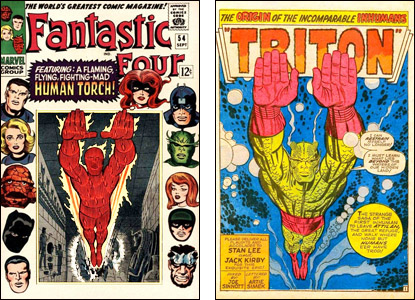
I opened my big, fat mouth and said, "Oh, you're using that old pose again!" It sounded funny in my head, but I realized as I said it, it sounded pretty damned smartass rude coming out of my mouth. If I'd said that to Alex Toth or a dozen other great, experienced comic book artists I've known, I would have gotten and probably deserved a scolding that began with something like "Who the f word are you to…?"
Jack said nothing of the sort. In fact, he said nothing. He just picked up his eraser, completely eradicated that lovely drawing of Superman and replaced it with another equally as fine (or maybe better) of Superman. In a different pose.
An hour or two later, I'd done my little insignia-drawing and Steve was packing the artwork up to go to the post office the next day. Jack came over to me and said in a sincere tone, "Thanks. You helped me there."
I said something like, "Hey, if you're ever ready to end your career, we could trade jobs. I could draw the story and you could draw the Superman emblems! We'd both be out of the business within a week."
Jack chuckled and said, "No, I meant about telling me I was overusing that pose. Any time you see me doing something like that, please let me know."
I think that says a lot about Jack Kirby as a creative force. There are lot of things one could nitpick about his work — the way he drew fingers, the way he drew women's hair, the way he even drew Superman's chest emblem when he drew Superman's chest emblem. But if you understood the way he approached that work, you could never say that he did the minimum effort necessary to get the check. The job did not leave his studio until he was satisfied he'd done his best work.
I learned a lot of things about comics from Jack but I'd like to think I learned even more about being a person.
2022 Retrospective and Award Eligibility
DP FICTION #94A: “Midwifery of Gods: A Primer for Mortals” by Amanda Helms
Slip Through Your Fingers: Thoughts on Andor
The Menu
“Diabolical Thoughts” Lineup Announcement
DP FICTION #93A: “The Restaurant of Object Permanence” by Beth Goder
Ziv W"Outside the archives, there’s a strange flyer on the bulletin board. It’s an invitation to the Restaurant of Object Permanence. To go, one is instructed to eat the flyer."
State of the Ziv, Tweepocalypse Edition
I don’t know how long Twitter’s going to be sticking around and semifunctional, but there’s no question my trust in the platform has dropped to nil.
So, here’s other places to find me on the web.
First and foremost — right here, on my website. Big things I’m involved in go here. Links to things I do elsewhere, also go here.
My Twitter account is remaining active, but I’m optimistic about Mastodon being nice; you’ll find me here.
The RSS feed for this blog is here, and here’s my Twitter thread about how to use an RSS Reader — they’re fantastic, and I’m glad to help people get started.
My YouTube channel has been quiet since my story structure videos, but I have a LOT of great material coming up for it really soon.
That’s it, folks. See you after the end of the world.
Magazines: More Than The Sum Of Their Stories
This post adapted from my Twitter thread, here.
I often urge readers to read entire issues of magazines. Even better, to read the same magazine on the regular. A thread about reading, popularity, and curation. Also about how you how awesome The Deadlands is, but we'll get to that.
An overwhelming bias in publishing is: popularity begets popularity. The easiest way to have something noticed, is for it to be by someone people are already paying attention to.
Broadly speaking, this is a great thing. Popular stuff is popular for a reason. And having your favorites, and following them, is the number one way to read great stuff that you enjoy.
But.
There's an insularity to it. If the barriers to getting published are high, then the barriers to being buzzy, to semi-virality, to being The Thing You Keep Hearing About, are phenomenal. And there's a lot of randomness to them (except inasmuch as marketing $$$ is involved).
Consider how this bias influences what you read in oh-so-many ways:
A solid story by a favorite vs. something amazing by someone unknown.
A quick read vs. a long one.
A piece with a great elevator pitch vs. something quiet, unexpectedly poignant.
A showstopper vs. a charming oddity.
Well, all right, you might be thinking to yourself. But how can you read things you haven't heard about?
One way — probably the easiest way — is by trusting a curator.
An editor crafting an issue, or an anthology, isn't trying to hook you on each story individually. They're building something that works as a whole. They're giving you a tour, weaving to and fro, pointing you at big exhibits and curious niches alike.
There's fantastic value and power in having different stories bundled together, large and small. It's one way to make sure that you're never limited merely to what's already on your radar. You are always, always trying something new.
(And while any one curator certainly brings in biases and preferences of their own, those are very different than the biases of "stuff I already like" and "stuff I hear about organically.")
To me, that's part of the amazing value of a magazine.
Will I like every single story?
Probably not.
But I'll be trying new stories, new authors, new styles, all the time.
And if it's an editor whose taste I like, I'm going to like a whole lot of those.
Now, if you want to see this difference between a story and a magazine, if you want to feel it in your bones, may I direct your attention to The Deadlands.
"a journal of ends and beginnings."
An issue of The Deadlands is an entirely different experience than simply "sitting down and reading a story."
The art, the poetry, the columns on undertaking and burial customs. And a dazzling range of stories; the macabre from angle after fascinating, unexpected angle.
![Ff7C_vmXwAQ_EcB[1].jpg](https://images.squarespace-cdn.com/content/v1/5e6e029380da441d9dd66208/1667145001602-FEI5V7EEDZGUI9HXWNWA/Ff7C_vmXwAQ_EcB%5B1%5D.jpg?format=1000w)
![Ff7DcxeXgAEoamL[1].jpg](https://images.squarespace-cdn.com/content/v1/5e6e029380da441d9dd66208/1667145042603-KCZL37ZVBBCNU3OOVDJJ/Ff7DcxeXgAEoamL%5B1%5D.jpg?format=1000w)
Without the context of a magazine, I would not be reading most of those.
Honestly, I would probably not be reading *any* of those. Not even my absolute favorites. How would I get to them?
The magazine bundles them together. It promises me, not "one good story (and some other stuff)", but a crafted, tailored visit that's full of new and unusual vibes, and so strong on variety and verisimilitude.
It's a magazine with so much voice, with a specific, dedicated vision. It's a magazine that does one unique, beautiful thing. Does it marvelously well. Shows that the one thing, the topic, the focus, the style, is bigger on the inside.
(This is no surprise, since Shimmer, also helmed by E. Catherine Tobler, had such a distinct, magnificent feel to it. In slush comments, I still sometime make a note saying, "this feels like a Shimmer story," and that says almost everything.)
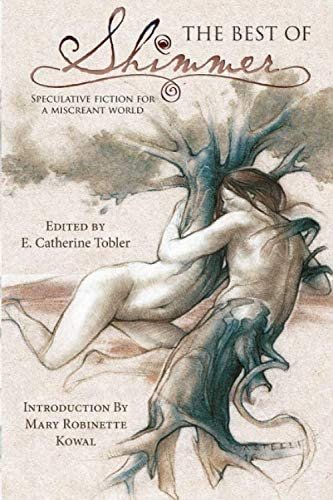
In our current state, with a vast, untameable ocean of wonderful fiction, it's so important to have these venues that promise its readers something specific, distinct, thrilling. It's what lets us sail far from the shore.
I think all magazines do this,
if you read your favorite cover to cover,
if you trust your editor enough to try at least a taste of each thing.
But in The Deadlands, that element is so clear, so visible, so distinct. It's got my admiration, and I've learned a lot from it.
I wrote this as the magazine was crowdfunding for Year 3. They’ve made their goal, but whenever you read this, consider checking them and and considering giving them a little support.
More than that, I hope you'll actually read the magazine, because it's something really special.
Understanding the Reader Without Pandering to the Reader
Ziv WThis is such a key observation in craft, and as usual, Lincoln explains it wonderfully.
A few days ago I tweeted a pithy bit of writing advice that, like most tweets, was only half-thought out:

Yet I think it’s also right. Or at least as right as right as vague writing advice can be.
At the most basic level, writing is form a communication in which ideas in one person’s mind are transferred to another’s mind via the medium of text. Certainly it’s more complicated than that—e.g., readers actively bring their own ideas and interests to a text and don’t absorb it passively—but that’s the gist. I think up a story and write it down on dead paper. You read it and the story comes alive again in your mind. Not in exactly the way I dreamed it, sure, but with a healthy amount of my dream’s DNA.
The point is the text is all the reader has to go on. While your novel/poem/story/whatever with all it’s great characters, important themes, deep symbolism, and thrilling events lives as a lush, wild jungle in your mind, the reader doesn’t have access to that. They only have the text. So the key—or at least a key—to writing is learning how to experience your text as the reader experiences it. That is, with nothing else. Just the words.
Yes, this is somewhat basic. But the older I get the more, the more I find the basics are the most important things. Writers spend a lot of time focused on the beauty of their language, the uniqueness of their voice, or the depth of their worldbuilding—all good things of course—but can sometimes gloss over the fundamentals. So in this post I’ll try to elaborate on this advice.
Not Pandering to the Reader
I’m going to start with the last part of that tweet. In recent years, I’ve noticed a shift away from talking about “the reader” in creative writing classes for some good reasons. Namely, many authors and critics with marginalized identities have rightly pointed out the way that creative writing classes can pressure writers to shape their work toward a very specific audience. Basically, well-off straight white people with a Western understanding of story structure. Students might be told to make a book less queer or more exoticized or in countless other ways to make their work less personal and more formulaic for this assumed audience.
That is one way to pander to the reader. And one sure to give us less interesting and more flattened works of art.
Another way to pander to the reader is to write towards your worst reader, fearfully trying to anticipate every bad faith reading and hedge off any possible offense. This makes for watered-down, anemic work. And it doesn’t work anyway. Someone somewhere will take offense no matter what you do.
When I say you should understand “the reader,” I don’t mean any specific audience. Nor do I mean the most bad faith reader eager to ding you on Goodreads and cancel you on Twitter. I also don’t mean your “ideal reader” or best reader, the one who will give you the benefit of the doubt on everything. What I mean is simply another mind which is not your mind. A mind that knows nothing except the words in the order they appear on the page.
Understanding the Reader
As writers, we (hopefully) know what we want to say in a story, even if we inevitably can’t fit it all in. We know more about our characters, more about our settings, and more about themes and points. It takes active work to understand how someone else will experience our stories without all that extra knowledge. When I teach workshops, I often suggest students begin their feedback letters with a summary of any given story. The reason for this is so the writer can learn what other readers took from the reading. What stood out or didn’t. What made sense or left questions. Often, the writers are quite surprised.
Here are some specific areas that often stand out to me along these lines:
Repetition:
Unless your book becomes part of some rabid geek fanbase or a English lit staple, few if any readers are going to read your stories with the Talmudic scrutiny you write and revise them. Readers are distracted. We read a story on a loud, crowded subway. We put a novel down midchapter and don’t get back to it for weeks. We read a chapter sleepily late at night. We miss things. What writers fear is beating their reader over the head is often doing the bare minimum to tap them on the shoulder.
This is a lesson even famous and award-winning authors can forget. I remember hearing a favorite writer give a craft talk and mention how in their first draft of a novel they had a line from chapter 1 repeated near the end of the book. “Aha, everyone will snap their fingers at the connection and realize the true identify of this character!” they thought. But then their editor, they said, quite rightly pointing out no one was going to remember that line 250 pages later. The novel needed to repeat that line four, five, or more times spaced out across the text for the reader to notice.
Order of information:
Outside of some experimental works, most stories are read lineally from start to finish and the reader only gets information in the order it appears in the story. Ask yourself if the information in the right order? If a reader isn’t told the relationship between two characters (lovers? rivals? former best friends?) until chapter 10, then their interactions in chapters 1-9 might not be as interesting as they could be. Certainly there are times in which withholding information is done for a specific effect, but far too often beginning writers don’t think about when information is revealed. They’re focused on the beauty of their sentences and not about whether the reader knows what they need to know when they need to know it.
Space on the page:
Repetition is one way to emphasize important elements, but not the only one. In general, the reader pays more attention to what is given the most space. Are the most pivotal scenes given the most space? Or are all scenes written with similar pacing and similar emphasis? Do the major characters appear the most? Does your main character think about the story’s important themes and ideas? Etc.
These are the kind of larger structural questions I ask myself when I’m revising my work. There are many smaller, line-level questions here too. I’ve written before about the “metaphor pile-up” when writers include several metaphors back-to-back without thinking about how these visual images will work in the reader’s mind. Even if you have several great lines, one strong metaphorical image might be more impactful than five contradictory ones piled up together.
To try and sum this up, the point is just that as writers we should try as much as we can to experience the text as another reader would. As just a text. Only the words on the page in the order they appear on the page. Ask yourself if the information in the right order for the reader to understand what you want them to understand? Are the important elements emphasized? Is the reader being directed toward the things you want to direct them to?
Sure, there are some experimental works that want to be an open field for the writer to frolic in whatever direction they desire. But for most stories, the text is a path in the woods the reader walks through from beginning to end. You have to give them the necessary signposts and directions if you want them to reach the right destination.
As always, if you like this newsletter, please consider subscribing or checking out my recently released science fiction novel The Body Scout, which The New York Times called “Timeless and original…a wild ride, sad and funny, surreal and intelligent” and Boing Boing declared “a modern cyberpunk masterpiece.”
Counter Craft is a reader-supported publication. To receive new posts and support my work, consider becoming a free or paid subscriber.
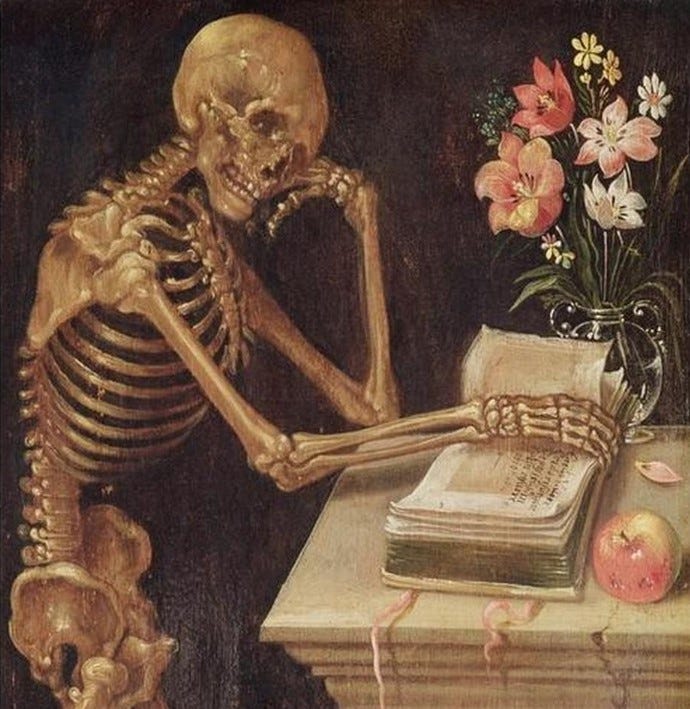


.jpg)
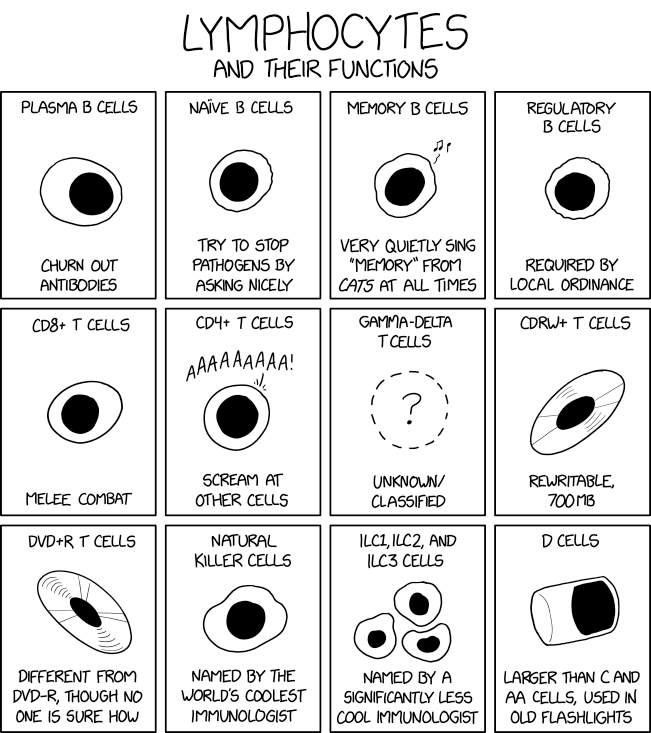

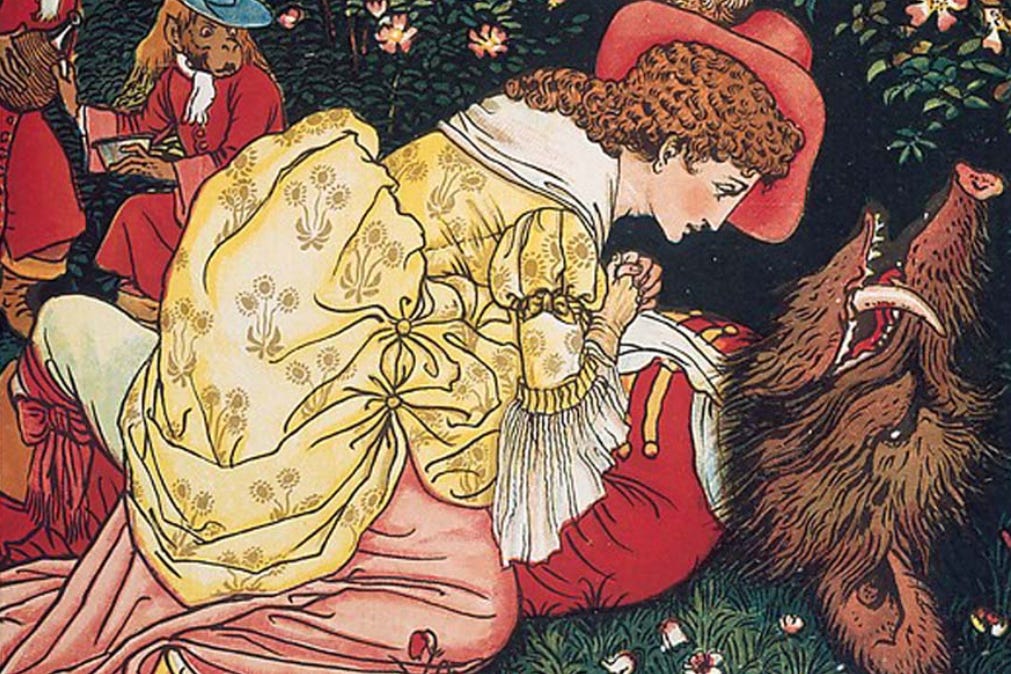
 Counter Craft
Counter Craft